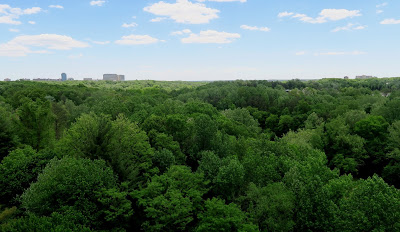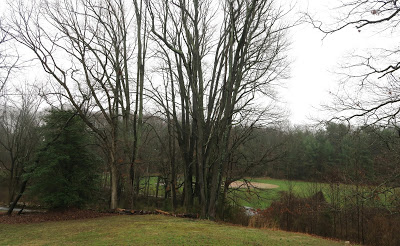Healthy trees can withstand a windstorm
 |
| Tree damage from windstorm. |
Much of the damage caused by trees crashing onto houses and power lines during last week’s windstorm could have been prevented, says Jim McGlone, an urban forest conservationist with the Virginia Department of Forestry.
Many of the trees that were uprooted were already dead or dying, McGlone told the audience at the Braddock District Tree Forum March 7. He advises homeowners to hire a qualified arborist to make sure their trees are in good shape. “Trees need healthcare, like your kids and pets,” he said.
 |
| The urban forest, as seen from the top floor of Lakeside Plaza on Columbia Pike, with the Mark Center in the background. |
When hiring an arborist, ask if they will top off your trees, he said. “If they say yes, walk away. A good arborist won’t do that.” To find a certified arborist that meets industry standards, look at GoodTreeCare.com.
All of the trees around here are part of the “urban forest” and we all need to take care of it, said Jeanne Kadet, the Braddock representative on the Fairfax County Tree Commission.
The Tree Commission is working on updating its Tree Action Plan, which will address the need to preserve the urban forest.
The entire Fairfax County is contained in an urban forest, McGlone said. He defined a forest as an ecosystem consisting of living things (plants, animals, bacteria, and fungi) and nonliving things (minerals, water, air, and light) that combine to produce soil. “An urban forest is a forest dominated people and the stuff they build,” he said.
Forests have many benefits, he said. They improve air quality, manage stormwater, store carbon, provide a habitat for animals, and recycle oxygen.
 |
| These trees are in Mason District. |
An urban forest provides additional benefits for people who live in them. They reduce energy costs through shading and ambient cooling. They lead to higher property values, lower vacancy rates, better employee retention, and even lower crime rates.
When people are looking out a window at trees, they send a message to would-be criminals that “people are paying attention,” he said. And when employees have a view of trees, they tend to be happier at work.
Studies have shown that when people have opportunities to interact with nature McGlone said, there is reduced stress, better overall health, reduced ADHD, improved immune system functioning, reduced anxiety and depression, and improved fetal health.
To maintain a healthy urban forest, he urged homeowners to practice integrated pest management, which limits the use of pesticides. Start with cultural solutions, then try biological controls, and if needed, use only pesticides that affect the specific pest that is causing problems.
Representatives from the Fairfax County Urban Forest Management Division said the best things homeowners can do for their trees is spread mulch widely and thinly around the base of trees and get rid of English ivy. One of the worst things is smothering a tree trunk in a big pile of mulch, which they called “volcano mulching.”
That office works with developers to minimize tree loss and cracks down on tree-trimming scams that exploit the elderly. When solicitors knock on doors promising to do tree work, residents should ask to see their solicitor’s license.
Fun fact: The most abundant trees in the Braddock district are American beech, tulip tree, and black gum, also known as tupelo.
Joan Allen and Rachel Griesmer-Zakhar, also with the Urban Forest Management Division, described some of the invasive pests that are attack trees.
The emerald ash borer, introduced from China in 2003 through nursery stock was eradicated, but re-entered the area in 2008. This pest has done a huge amount of damage to ash trees, to the point that they are becoming extinct in this area.
The larvae of the emerald ash borer burrows under the bark, and the caterpillars eat the tree from the inside out. Infested trees have a lot of bare branches and sprouts near the ground.
If the tree isn’t totally destroyed, it’s possible to save it by injecting chemicals directly into the tree or soil. There’s also a biological remedy using a certain kind of tiny wasp that lay eggs inside the emerald ash borer when it’s in the aphid phase.
Another tree pest, the spotted lanternfly, arrived from Eastern Asia in 2014. It was first spotted in Pennsylvania and has since spread to other states and showed up in the Winchester, Va., area about two months ago. This pest is particularly harmful to fruit trees, grape vines, and black walnut trees.
 |
| Roundtree Park |
The Asian Longhorned Beetle attacks a wide range of trees, although it prefers maples, but hasn’t yet shown up in Virginia. The female lays eggs on a tree and the larvae eat through the inside of the trunk. Once it gets into a tree, the damage is so devastating, an infected tree can’t be saved.
To ensure a healthy urban forest, it’s important to replace dead and dying trees and shrubs with natives – and not invasive species. Smaller trees, the “understory,” in a forest, are important to provide a varied habitat for wildlife, and most songbirds actually prefer smaller trees, said Alan Ford, president of the Potowmack Chapter of the Virginia Native Plant Society.
If you have room for one large canopy tree, Ford recommends the white oak. For understory trees, he suggests the flowering dogwood, eastern redbud, and American witch hazel.
The common ninebark is good for erosion control and has beautiful clusters of white flowers in the spring and provides dense cover for nesting birds, he said. The blackhaw viburnum attracts native bees and produces berries favored by the cedar waxwing, he said.
The sweetbay magnolia attracts various birds, as well as the tiger swallowtail, and the American persimmon is a host plant for the luna moth.
All of the native trees and plants mentioned by Ford are available from Earth Sangha.


When we were getting a permit for a pool several years ago, Fairfax county required we plant 3 trees plus several shrubs. The inspector was very specific about what species was planted and where it was to be planted.
The thing is, none of the trees specified for the permit were native. All but one has since died. You would think that Fairfax county would want native trees that would actually grow here.
This is a very good article and informative as well. However, most people that read the blog are generally well informed. The problem is that the uniformed, particularly people from other lands, and I don't mean W Virginia. Many of these folks have poor English skills and for the most part read and communicate in their native language. That is a huge demographic in Mason District. And when those tree chuckers pronounce themselves as the experts in topping off or chopping down trees, the less educated on this subject believes them. This leads to what amounts to scam artists taking advantage of illegal,legal aliens, the elderly and those who just don't know.
The County needs to be a responsible agent and step in here and send every homeowner a letter informing all of the does and don'ts regarding tree care and cutting down trees with graphics so that everyone can understand.
The lack of attention to this matter makes everyone suffer due to a compromised tree canopy and harmful pollutants and heat normally addressed by trees.
I don’t know when “volcano mulching” became popular, and I don’t know why it persists, but it has to stop! It’s wasteful & harmful & I don’t know why so many landscaping companies persist in this bad practice.